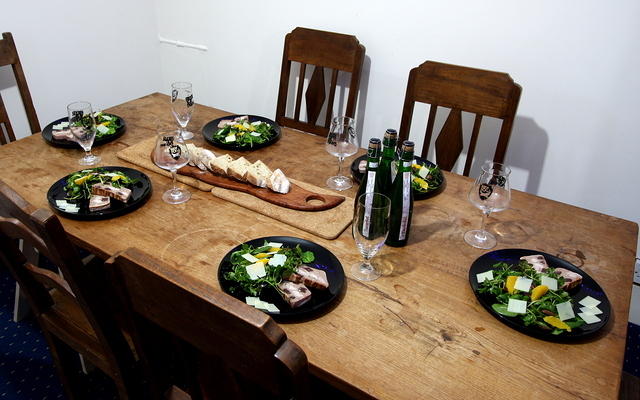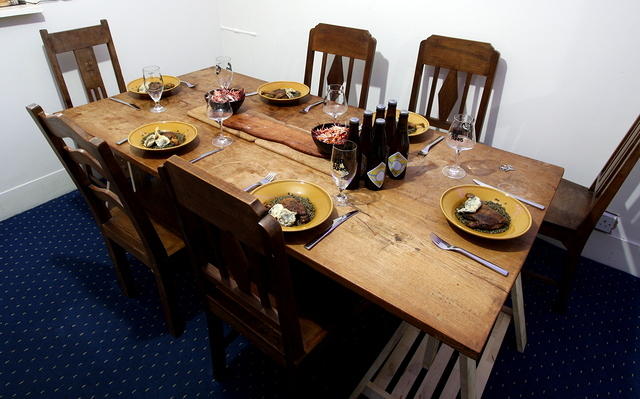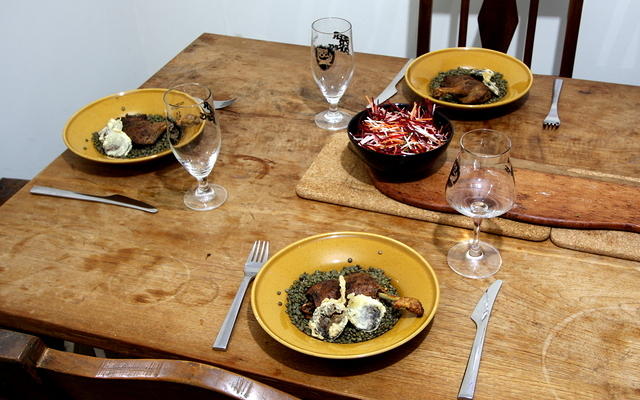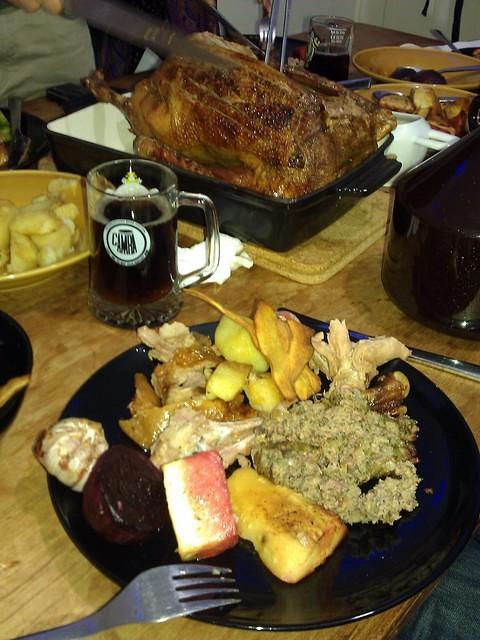Christmas is somewhat empty of meaning to me. This comes from having no religious inclinations whatsoever, being above the age of 12, and generally being a cynical, consumerism-hating, contrarian. That said, Xmas is a good excuse to get a few people together and cook some damn fine food. It is an opportunity to put together the sort of varied menu that just isn’t an option in a household of two people.

Beery Christmas!
There seems to be a trend amongst British beer aficionados for considering beer something to be “matched” with food. It is certainly a topic being covered more often by the serious beer-bloggers I follow. I believe that outside the UK the idea of matching beer with good food is more common; but within the UK the public’s regard of beer is quite specific and doesn’t generally intersect with “fine dining”.[1] Pub lunch and a pint of bitter, this is acceptable; but how many proper restaurants do you see serving decent beer? There is a desire to elevate beer from its pint-swilling-in-pubs position in British culture, to place it alongside wine as something very much at home on a menu and the dining table. Things do seem to be improving. There are obvious examples where brewers are trying to position beer in this way, such as BrewDog James’s Musa restaurant in Aberdeen. But more telling incarnations are restaurants and, dare I say it, “gastropubs” that take both food and beer seriously. We have a local restaurant of this sort, two hand-pumps dispensing always-fresh and in-condition ale from local breweries are prominent at the bar and real ale even gets a wordy mention in the drinks section of the menu.[2]
The whole food/beer matching thing seems a bit “well, duh!” I’ve been selecting beers to go with the food I eat for a long time now, much as I always have with wines. Hearty casserole? A good rich red wine, something with loads of dark fruit and a tannic mouthfeel, peppery and preferably with the distinct notes of a good oaking. However, I’m just as likely to plump for rich, fruity beer with dark malt and caramel notes. In fact, these days I’m much more likely to select beer than wine. It doesn’t stop at main course, there are beers that are great with cheese, even with dessert.
Beer also has a place in cooking beyond “beer batter”. I’ve been experimenting more with this lately. Mostly it has worked well, but a couple of times the results have been terrible – the main thing to be wary of is bitterness. I basted a pheasant with BrewDog’s Trashy Blond once, the bird turned out OK with an unusual bitter bite, but the gravy was inedible.
Returning now to the annual event of “Christmas Dinner”. I recently read a blog post by Dave Bailey, of HardKnott brewery fame, which covers the topic of matching beers with Christmas dinner. This prompted me to think a bit harder and be more specific about beer matching for the Christmas meals I’m preparing.[3] Normally I’d just pull some vaguely appropriate beers from our collection. Or select wine, as it is more acceptable to the uninitiated. However, this time each course has had a specific beer matched to it in advance – well, “matched” to the best of my abilities. The beer selection has then also fed back into the course itself with a tweak here and there. Though I haven’t the time to experiment with fusing the beers into the actual cooking of the courses. It’ll be interesting to see how it is received by our non-“beer-geek” guests. I may ask them to take notes.
1st Course
Terrine of sweetbreads, black pudding, and spiced pork mince
Served with a salad of rocket, fresh orange, Kalamata olives, and shaved Pecorino Romano – with a zesty orange vinaigrette
1st Beer: Lambic/Tripel
Brouwerij Loterbol “Tuverbol” (2007) – 10.5% (Belgium)
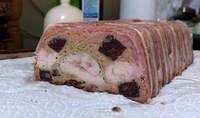
Terrine
The Tuverbol is a lambic/tripel blend and has a typical lambic sourness but also added body from the tripel. When I tried this a while ago my notes on Twitter were “tannic, orangepeel, warm spice”. Initially I was looking for a lambic/gueuze to go with this course, as I think the sharpness would suit cold-served terrine. However, I decided that this lambic blend is a bit more friendly to the uninitiated and more compatible with the dish. The orange/spice notes should work with the terrine, which I’ve spiced with a little ground coriander, allspice, and Chinese 5-spice. Complimenting this I’ve decided to add orange segments to the salad plus a squeeze and a bit of zest to the vinaigrette.
This course will be served at about 11:00 (AM), the beer may seem a bit strong for “breakfast” but note that only a small glass of it will be served. (I wish I had champagne glasses – but I’ve never got the hang of the stuff, must remember to buy some for beer use.) After this course we’ll pop up to our local pub for a communal pint or two before heading home to relax a bit before the…
2nd Course
Whole confit duck leg
Served with tempura black pudding pieces, lemony puy lentils, and a salad of julienne celeriac, carrot, and beetroot
2nd Beer: Witbier
Beer: Brouwerij ‘t IJ “Scharrel IJwit” (Netherlands)
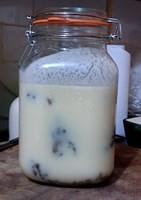
Confit
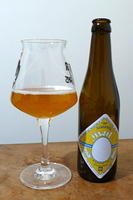
IJwit
I was uncertain about what to pair with the duck. I was after something that’d cut the richness of the duck and black pudding, but I’d already selected a lambic style beer for the first course. I was thinking of a light, modern, hoppy beer, something using citra hops perhaps. Then I had a chat about the menu and beer pairings with one of the guys at Bacchanalia and he suggested a wit – an excellent idea. There were few to choose from unfortunately, just two in fact, so I selected the one that was recommended but chose a Hefeweizen as a backup as its a “safe” style of beer (my tertiary backup was BrewDog’s Punk X).
The IJwit is true to the style: lemon/citrus, crisp, wheaty. A nice foil, I think, to the rich saltiness of the confit duck. I’ll try to compliment the beer with a dash of lemon juice used in dressings for the dish.
I expect we’ll tuck into the duck at around 15:00 and follow that with a siesta, or a walk if the snow still looks good, or perhaps watch a DVD or two… while I prepare the…
3rd Course
Roast Goose
Served with the usual bits and bobs: a pear, currant, and walnut “stuffing”; roast vegetables; parsnip chips; something green perhaps …
3rd Beer: Real Ale?
Ringwood “Old Thumper” – 5.6% (UK)

Goosey
A traditional beer for a traditional meal? I specifically wanted a fairly authentic “real ale” style of beer to go with this course. Unfortunately that’s a bit difficult to achieve with bottled beer. As a result, it is with this course that I’m least happy about my current beer choice. Still, I’ve persevered and considered bottled ales I’ve tried and, for “research purposes”, tasted a few additional bottled ales from the supermarket. As it is such a large and hearty meal I want something tasty but below the 6% mark, it is also ideal for it to be rich yet easy drinking – which rules out most of my favourite “hoppy” beers. A beer I have in mind is Tring’s Colley’s Dog, a favourite at our local pub. (There are people who’ve been drinking in this pub exclusively to drink this beer for years now. A pint is a “doggy” and a half is a “puppy”.) Anyway, Colley’s Dog isn’t locally available in bottles and I suspect that the bottled version would pale in comparison to a fresh pint pulled in the pub. (I’ve tried a few of my favourite small-brewery ales in bottled form over the years and the result is always disappointment.)
For now I’ve selected a bottled beer in the form of Ringwood’s “Old Thumper”. I picked a few “strong” ales from the selection available in Waitrose and tried them over a couple of nights. In the end I decided that Ringood’s “Old Thumper” was most appropriate. It is refreshing for a 5.6% ale, but still delivers good malt notes and some sweetness. The background hop notes have a peppery/herbal edge. These herbal notes from the hops will match the seasoning used on the roast bird and vegetables (pepper, fresh marjoram, thyme, and bay) and I may add some Old Thumper to the stock I use for basting and making the gravy. (I’ve experimented with beer based basting and gravy before, it requires some care as the bitterness from the beer can be too much when you reduce the gravy.)
This is the only beer choice still subject to change at this late date. I’m considering grabbing a couple of 4 pint carrykegs (growlers) of whatever I consider most appropriate, when we make our quick trip up to the local between the 1st and 2nd courses. This is a decision that could very well be made on Christmas day itself.
The roast goose should be served at about 19:00, and will be followed by a brief gallivant involving some pyrotechnics. Leading on to the…
Palate cleanser
The “palate cleanser” is an idea lifted from Dave Bailey’s beer/XmasDinner-matching blog entry. I tried this beer a few months ago and really enjoyed it – while it probably isn’t as “palate cleansing” as a gueuze, it is refreshing and a bit tart so should do a decent job in this role.
I expect we may sit down and relax while sipping this beer before dessert. Possibly while watching a suitable Christmas DVD, I have some seminal 70s sci-fi in mind but could be overruled. Dystopian melodrama might not be considered appropriate. I think I could settle for a couple of episodes of Red Dwarf instead. Anyway, as eventually we shall enjoy…
Dessert
Traditional Christmas Pudding made with Nethergate Old Growler Porter
Possibly served with a whisky crème-anglaise and vanilla-bean icecream
Dessert Beer
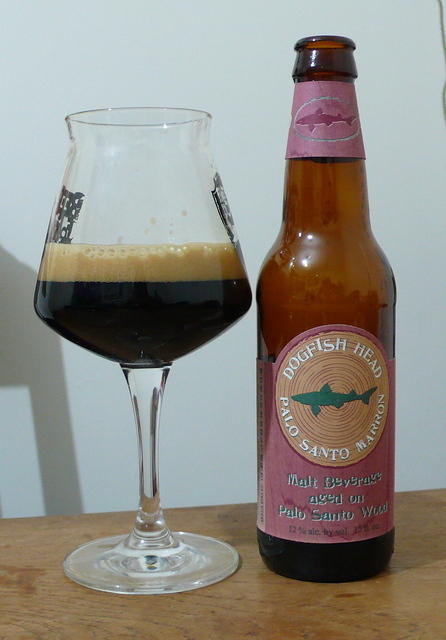
Palo Santo Marron
The Palo Santo Marron is one of those “pudding in a bottle” beers. While writing this I’ve poured myself a glass and come up with: “super rich, chocolate sauce, sandalwood & vanilla, a trailing spiced licorice molasses warmth, a lingering sense of burnt toffee.” What better to go with Christmas pudding?
I must confess: the pudding is the only part of the planned meal that I will not have made from scratch (well, ignoring ingredients like bacon and black pudding – although I have made the former myself in the past.) I’m really quite anxious about this. We bought the pudding from the local last year and it’s a “Nethergate Old Growler” pudding, which was a favourite porter of ours that used to be near-permanent at said local. I’m just hoping the pudding will live up to my standards; or, failing that, the exquisitely rich beer covers for any failings on the part of the pudding.
I also plan to serve the pudding with a “whisky anglaise”, using a mere dash of a peaty Laphroaig. That said, I’m seriously considering attempting to use a chocolate sauce that incorporates the beer instead. In which case I think I’d have to serve dessert with some vanilla-bean icecream.
Beer beer beer! Food food food!
While the “menu” above may seem notable for the sheer volume of food and beer, it should be taken as an “all day” schedule as detailed in the last of the notes for each course. The beer list may be notable for the fact that it is missing beers from my favourite British craft brewers. No BrewDog, HardKnott, or Moor beers – for example. I’ve spurned BrewDog on purpose: fearing my friends may think I’m a little too obsessed. I did experiment with some beers from HardKnott and Moor and decided not to run with them. Moor’s Old Freddy Walker was almost the dessert beer, but it wasn’t “puddingy” enough. I’d definitely have used HardKnott AetherBlaec if I had more than one bottle left, I could match that nicely with a whisky-anglaise. I was also thinking of pairing HardKnott Infra-Red with the confit, but that’d just look like I was stealing the brewer’s suggestion of pairing it with duck. Not to worry, beers from all these breweries – and more – will be enjoyed over the Christmas period.
Bon appétit!

Pork
[1] My father gave me a book by Garrett Oliver called “The Brewmaster’s Table: Discovering the Pleasure of Real Beer with Real Food“. This book was written by an American author who “discovered beer” some 20 years ago – in London. The first two paragraphs of his introduction pretty accurately describe my real ale experience on moving to the UK. However, no mention of food is until he buys his European rail pass and hits the mainland. The book then continues through a wide coverage of beer styles and specific beers and discusses pairing them with food. (British ales are given worthy consideration, though with a lot of reference to pub food. Unfortunately the specific breweries and beers covered seem a bit dated and mainstream.) I think the book is very much worth reading if you’re interested in beer and especially if you’re also interested in food.
[2] Things start to fall apart when the staff come onto the scene unfortunately. They could also do with a more adventurous selection of kegged beers, I like the idea of a “guest keg”. The bottled beer selection is, unfortunately, just plain crap. What’s required is a “sommelier” who also loves and can recommend beer/food pairings – sounds like my kind of job! Probably wouldn’t pay the rent though.
[3] Christmas dinner preparations began 2 months ago when I ordered the goose and confited the duck legs, continued 2 weeks ago when I ordered a forequarter of pork and have featured heavily since. Tasting beer (aka “research”) featured in this time as well – with a particular focus on cleaner food matchings. I had to butcher the pork, which is now mostly wrapped up as dice, mince, and rolled roasts in the freezer. The mince is required for the terrine and stuffing. (The value you can get out of buying a whole forequarter of pork is amazing.) This was the main activity of the weekend just passed, along with the making the terrine using lamb sweetbreads I’d reserved from their spring availability. (I also made venison Xmas mince pies, I’ll write about these separately.)
Like this:
Like Loading...
